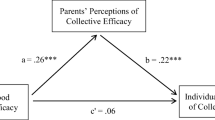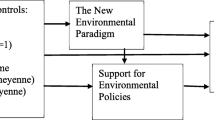Abstract
This article explores individual and community action taken in response to perceived environmental risks by investigating the determinants of environmental action across a range of action types. A conceptual framework is first presented, which provides a foundation for investigating the role of local compositional (i.e., individual characteristics), contextual (i.e., neighborhood environment), and collective (i.e., social networks) factors in environmental action. To test the utility of the conceptual framework, a quantitative survey was administered to a random sample of households (n = 512) in Hamilton, Canada. The results suggest that the predictors of environmental action vary by action type (i.e., personal change, individual civic action, and cooperative civic action), and that factors related to perceived environmental exposure and social capital generally play a stronger, more consistent role in civic environmental action than sociodemographic or neighborhood factors. The results underscore the role of social connection in responses to perceived environmental risks.


Similar content being viewed by others
Literature Cited
Agyeman J. 2002. Constructing environmental (in)justice: transatlantic tales. Environmental Politics 11(3):31–53
Agyeman J., B. Evans. 2004. “Just sustainability”: The emerging discourse of environmental justice in Britain? The Geographical Journal 170(2):155–164
Arnstein S. 69. A ladder of citizen participation. Journal of the American Planning Association 35:216–224
Blake D. E. 2001. Contextual effects of environmental attitudes and behavior. Environment and Behavior 33:708–725
Corraliza, J. A., and J. Berenguer 2000. Environmental values, beliefs, and actions: A situational approach. Environment and Behaviour 32:832–848
Dietz T., P. C. Stern, G. A. Guagnano. 1998. Social structural and social psychological bases of environmental concern. Environment and Behavior 30:450–471
Dunlap R. E., K. D. Van Liere, A. G. Mertig, R. E. Jones .2000. New trends in measuring environmental attitudes: Measuring endorsement of the New Ecological Paradigm, a revised NEP scale. Journal of Social Issues 56:425–442
Elliott S. J., D. C. Cole, P. Krueger, N. Voorberg, S. Wakefield. 1999. The power of perception: Health risk attributed to air pollution in an urban industrial neighbourhood. Risk Analysis 19:615–628
Elliott S. J., S. M. Taylor, S. Walter, D. Steib, J. Frank, J. D. Eyles. 1993. Modeling psychosocial effects of exposure to solid waste facilities. Social Science and Medicine 37:791–804
Feitelson E., G. Lindsey. 2001. Local use of economic instruments in the Chesapeake Bay Critical Area Programme. Journal of Environmental Planning and Management 44(2):187–206
Ferrero, L. 2002. Making up one’s self: Agency, commitments, and identity. Ph.D. dissertation in philosophy, Harvard University, Cambridge, Massachusetts, January 2002
Finger M. 1994. From knowledge to action? Exploring the relationships between environmental experiences, learning, and behavior. Journal of Social Issues 50:141–160
Furuseth O., C. Cocklin. 1995. Regional perspectives on resource policy: Implementing sustainable management in New Zealand. Journal of Environmental Planning and Management 38(2):181–200
Gardner G. T., P. C. Stern. 1996. Environmental problems and human behavior. Allyn and Bacon, Boston
Godschalk D. R., S. Brody, R. Burby. 2003. Public participation in natural hazard mitigation policy formation: Challenges for comprehensive planning. Journal of Environmental Planning and Management 46(5):733–754
Green L. W., M. W. Kreuter. 1991. Health promotion planning: An educational and environmental approach. 2nd ed. Mayfield Publishing, Mountain View, California
Greenberg M. R., D. Schneider. 1997. Neighborhood quality, environmental hazards, personality traits, and resident actions. Risk Analysis 17:169–175
Gould K. A. 1993. Pollution and perception: Social visibility and local environmental mobilization. Qualitative Sociology 16:157–178
Grodzinska-Jurczak M., M. Tarabula, A. D. Read. 2003. Increasing participation in rational municipal waste management: A case study analysis in Jaslo City (Poland). Resources, Conservation, and Recycling, 38(1):67–88
Hamilton Air Quality Initiative. 1997a. Summary report. Regional Municipality of Hamilton-Wentworth, Hamilton, Ontario
Hamilton Air Quality Initiative. 1997b. Human health risk assessment for priority air pollutants. Regional Municipality of Hamilton-Wentworth, Hamilton, Ontario
Hosmer D. W., S. Lemeshow. 2000. Applied logistic regression. 2nd ed. John Wiley and Sons, Hoboken, New Jersey
Hummon D. M. 1992. Community attachment: Local sentiment and sense of place. In I. Altman S. M. Low (eds.) Place attachment. Plenum Press, New York. pp: 1–12
Ife J. 1995. Community development. Longman, Melbourne
Jerrett M., P. Kanaroglou, J. Eyles, N. Finkelstein, C. Giovis. 2000. A GIS-environmental justice analysis of particulate air pollution in Hamilton, Canada. Environment and Planning A 33:1–19.
Jones R. E., R. E. Dunlap. 1992. The social bases of environmental concern: Have they changed over time? Rural Sociology 57:28–47
Kaplan S. 2000. Human nature and environmentally responsible behavior. Journal of Social Issues 56:491–508
Kollmuss A., J. Agyeman. 2002. Mind the gap: Why do people act environmentally and what are the barriers to proenvironmental behavior? Environmental Education Research 8:239–260
Langton S. 1978. Citizen participation in America. DC Health, Lexington Massachusetts.
Lazarus R. S. 1993. Coping theory and research: Past, present, and future. Psychosomatic Medicine 55:234–247
Luginaah I. N., S. M. Taylor, S. J. Elliott, J. D. Eyles. 2000. A longitudinal study of the health impacts of a petroleum refinery. Social Science and Medicine 50:1155–1166
Macintyre S., A. Ellaway, S. Cummins. 2002. Place effects on health: How can we conceptualise, operationalise, and measure them? Social Science and Medicine 55:125–139
Mackenzie A. F. D., S. Dalby. 2003. Moving mountains: Community and resistance in the Isle of Harris, Scotland, and Cape Breton, Canada. Antipode 35(2):309–333
Mayer M., R. Roth. 1995. New social movements and the transformation into a post-Fordist society.Pages 299–319 In M. Darnovsky B. Epstein R. Flacks (eds.) Cultural politics and social movements. Temple University Press, Philadelphia.
McGurty E. M. 2000. Warren County, NC, and the emergence of the environmental justice movement: Unlikely coalitions and shared meanings in local collective action. Society and Natural Resources 13:373–387
Nevitte N. 1996. The decline of deference. Broadview Press, Peterborough, Ontario.
Nevitte N., M. Kanji. 1995. Explaining environmental concern and action in Canada. Applied Behavioral Science Review 3:85–102
Northridge M. E., P. M. Shepard. 1995. Environmental racism and public health. American Journal of Public Health 87:730–731
Offe C. 1985. New social movements: Challenging the boundaries of institutional politics. Social Research 52(4):817–868
Perkins W. H., D. K. Demeis. 1994. Gender and family effects on the “second shift” domestic activity of college-educated young adults. Papers of the American Sociological Association (ASA). Hobart & William Smith Colls, Geneva, New York
Putnam R. 1993. Making democracy work: Civic traditions in modern Italy. Princeton University Press, Princeton, New Jersey
Putnam R. D. 2000. Bowling alone: The collapse and revival of American community. Touchstone, New York
Ranzjin R., J. Keeves, M. Luszcz, N. T. Feather. 1998. The role of perceived usefulness and competence in the self-esteem of early adults: Confirmatory factor analyses of the Bachman Revision of the Rosenberg Self-Esteem Scale. Journal of Gerontology 53B:96–104.
Regional Municipality of Hamilton-Wentworth. 1995. Commuter study for Hamilton-Wentworth and surrounding areas. RMHW Planning and Development Department, Hamilton, Ontario
Rissel C. 1994. Empowerment: The holy grail of health promotion? Health Promotion International 9:39–47
Rochon T. R. 1998. Culture moves: Ideas, activism, and changing values. Princeton University Press, Princeton, New Jersey
Rohe W. M., V. Basolo. 1997. Long-term effects of home ownership on the self-perceptions and social interaction of low-income persons. Environment and Behavior 29:793–819
Rydin Y., M. Pennington. 2000. Public participation and local environmental planning: The collective action problem and the potential of social capital. Local Environment 5(2):153–169
Seguin C., L. C. Pelletier, J. Hunsley 1998. Toward a model of environmental activism. Environment and Behavior 30:628–652
Slovic P. (ed). 2000. The Perception of Risk. Risk, Society, and Policy Series, Earthscan Publications, London
Statistics Canada. 2001. 1998 National Population Health Survey Results. Available at: http://www.statscan.ca (Accessed 12 Feb 2002)
Stern P. C. 2000. Toward a coherent theory of environmentally significant behavior. Journal of Social Issues 56:407–424
Stern P. C., T. Dietz, T. Abel, G. A. Guagnano, L. Kolof. 1999. A value-belief-norm theory of support for social movements: The case of environmental concern. Human Ecology Review 6:81–97
Uyeki, E. S. 1999. Environmental beliefs, intended action, and behavior. American Sociological Association (ASA) Association Paper. Washington, DC
Vigoda E. 2002. From responsiveness to collaboration: Governance, citizens, and the next generation of public administration. Public Administration Review 62(5):540
Vorkinn M., H. Riese. 2001. Environmental concern in a local context: The significance of place attachment. Environment and Behavior 33:249–263
Wakefield S., S. Elliott, D. Cole, J. Eyles. 2001. Environmental risk and (re)action: Air quality, health, and civic involvement in an urban industrial neighbourhood. Health and Place 7:163–177
Walker P. A. 2003. Reconsidering “regional” political ecologies: Toward a political ecology of the rural American West. Progress in Human Geography 27(1):7–24
Walsh E., R. Warland, D. C. Smith. 1993. Backyards, NIMBYs, and incinerator sitings: Implications for social movement theory. Social Problems 40:25–38
Wilkinson R.G. 1997. Health inequalities: Relative or absolute material standards? British Medical Journal 314:591–595
Wrigley N. 1985. Categorical data analysis. Longman, London
Zeiss C. 1998. Cause and effect patterns of noxious facility impacts on property values. Journal of Environmental Systems 26:111–136
Zelezny L., P. W. Schultz. 2000. Theory and research on environmental attitudes and behavior. Journal of Social Issues 56:365
Acknowledgments
This research was supported by a Social Science and Humanities Research Council (SSHRC) and the Canadian Health Services Research Foundation (CHSRF) joint doctoral fellowship. Some additional funding was provided by the Hamilton-Wentworth Public Health Department.
Author information
Authors and Affiliations
Corresponding author
Rights and permissions
About this article
Cite this article
Wakefield, S.E.L., Elliott, S.J., Eyles, J.D. et al. Taking Environmental Action: The Role of Local Composition, Context, and Collective. Environmental Management 37, 40–53 (2006). https://doi.org/10.1007/s00267-004-0323-3
Published:
Issue Date:
DOI: https://doi.org/10.1007/s00267-004-0323-3




